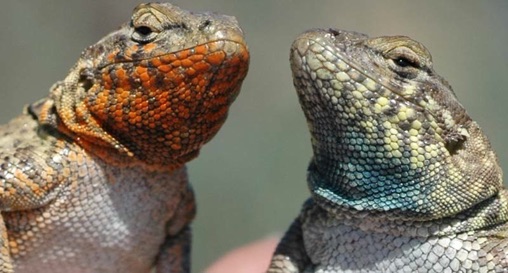My doctoral research focused on understanding how polymorphic mating systems evolve and on testing the theory that polymorphism could be the precursor to new species. I studied the side-blotched lizard, Uta stansburiana, a species that is polymorphic for three different genetically determined male mating strategies characterized by distinct throat colors and mating behaviors. The mating strategies are maintained by an evolutionary analogue of the rock-paper-scissors game wherein orange males take territory from blue males because they are more aggressive, yellow males beat orange males by sneaking onto their large territories, and blue males beat yellow males by closely guarding their mates. I studied the geographic variation of this polymorphism, reconstructed its evolutionary history, and tested whether divergence in morphs was likely to promote speciation. I found that the mating strategy polymorphism is geographically widespread, is the ancestral state for the species, and likely predated speciation of Uta. These results demonstrated that rock-paper-scissors dynamics can maintain a polymorphism for millions of years. However, I also showed that even this highly stable system for maintaining diversity can destabilize because there have been eight independent losses of the polymorphism. Widespread convergent evolution has occurred because in all cases the allele that gives rise to the yellow sneaker male strategy has been lost (e.g. the two lizards pictured above come from Anacapa Island, which only has orange and blue morphs). Using phylogenetic tests, I showed that polymorphism loss was associated with rapid phenotypic evolution of body size and sexual size dimorphism. This rapid evolution could promote species formation and, consistent with this idea, my phylogeographic results showed that the formation of distinct subspecies/species was often concordant with polymorphism loss.
Publications
Corl, A., A. Davis, S. R. Kuchta, and B. Sinervo. 2010. Selective loss of polymorphic mating types is associated with rapid phenotypic evolution during morphic speciation. PNAS. 107: 4254-4259. [link]
(See a news article about this research at: http://news.ucsc.edu/2010/02/3544.html)
Corl, A., A. R. Davis, S. R. Kuchta, T. Comendant, and B. Sinervo. 2010. Alternative mating strategies and the evolution of sexual size dimorphism in the side-blotched lizard, Uta stansburiana: a population-level comparative analysis. Evolution. 64: 79-96. [link]

